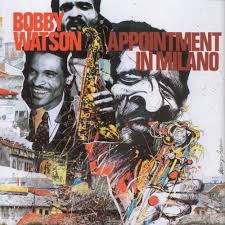Appointment In Milano – Robert Watson
A catchy medium-up groover with a slightly mysterious mood. In addition to Bobby's own version, we have Minus You part and tracks in a different key.
- Recording: Bobby Watson - Appointment In Milano
- Recorded on: February 5, 1985
- Label: Red (VPA 184)
- Concert Key: G minor
- Vocal Range: , to
- Style: Swing (medium up)
- Alto Sax - Bobby Watson
- Piano - Piero Bassini
- Bass - Attilio Zanchi
- Drums - Giampiero Prina
Video
- Description
- Historical Notes
- Solos
- Piano Corner
- Bass Corner
- Drum Corner
- Guitar Corner
- Inside & Beyond
- Minus You
On this recording, the piano plays chords in the intro and A section on the downbeat, holding them for two measures each. The drums tacet in these sections, and there are finger snaps on the second beat of every measure. Bobby improvises around the vamp on the last eight measures of the B sections.
The Melody Transcription shows Bobby's interpretation of the melody on this recording. This includes the improvisations on the B section vamps. With this transcription you can explore the nuances of his expressive melodic style.
The quintet arrangement has a slightly different intro, with the piano chords starting on beat 2 instead of on the downbeat. The second beat of each measure in the intro has a hi-hat click instead of a finger snap; these come in at the beginning, before the piano enters. The last eight measures of the head have a much looser feel, with the bass holding longer notes instead of playing the intro vamp. The sextet arrangement is largely a piano feature (Ronnie Mathews is the soloist on the recording).
Related Songs
Email Send Appointment In Milano to a friend
- Recording: Don Sickler - Further Explorations Vol. 1
- Recorded on: May 27, 2003
- Label: jazzleadsheets.com (JLS 1034)
- Concert Key: F minor
- Vocal Range: , to
- Style: Swing (medium up)
- Flugelhorn - Don Sickler
- Piano - Cecilia Coleman
- Bass - Tim Givens
- Drums - Vince Cherico
Video
- Description
- Historical Notes
- Solos
- Piano Corner
- Bass Corner
- Drum Corner
- Guitar Corner
- Inside & Beyond
- Minus You
The feel for the solos is less of a groove, more of a washy, "broken" 2-feel. After the solo choruses, there is an interlude (letter H)—eight more measures of the vamp with piano soloing and an optional melody line before the head out. The piano also solos on the coda, which replaces the C section (the out head is only once); on our parts, there is a transcription of the flugelhorn melody from the recording for the entire coda vamp.
Don Sickler: "I've always loved this composition, and in 1993 I got a chance to solo on this interesting form on the T.S. Monk recording. Now, I've been able to do my own quartet recording, which is in the key of F minor concert.
"This is also a Minus You edition, so any melody instruments can get the track without me (minus Melody track) and explore this great composition themselves. Individual rhythm section editions and Minus You audio tracks are also available so rhythm section players can have fun playing it with me."
Pianist James Williams introduced Bobby Watson and several other musicians to Second Floor Music in the early 1980s. James had his own compositions, plus those of other musicians, in his company Flying Colors Music. He decided that he would rather put all his energy and focus into playing and composing, rather than the business area of registering and accounting for songs, so he assigned his entire catalog to Don Sickler's Second Floor Music. Some composers, like Bobby and his wife Pamela Baskin-Watson, decided they liked the idea, too.
The drummer on this session plays very light time on the ride cymbal, light snare comping accompanied by an open hi-hat splash with his foot on beat 2 of every other bar (see the Drum part and recording). The piano also plays this beat 2 pattern.
The solo section has a few different vibes you are responsible for setting. E mirrors the intro and the A sections of the melody. F introduces new harmonic material and should be played with a standard swing 4-feel. G calls for a more open or spatial feel. The changing of feels makes playing along with the Minus Drum track very fun for the drummer and good practice as well.
Keeping the form and setting the feeling for each section of a tune is one of the most important parts of a drummer's role in a band. The drummer is really the player who sets the feeling or vibe of a given tune (or a portion of it). This is partially because drums have the greatest dynamic range of any instrument (they can be very loud or very quiet).
Intro: Drums tacet (don't play) for first eight bars. Bass plays alone. Enter with piano and flugelhorn. Groove is very light ride cymbal swing time. Highlight beat 2 of every other bar with open hi-hat foot splash.
Melody: keep the groove simple and light, with that beat 2 on the hi-hat. Play and use fills to set up the figures at B which is a six-bar section
Solos: Alternate between the melody groove, 4-feel swing and broken time where appropriate. This tune is great for practicing a form that changes feels within the same meter (4 in this case).
Exclusive Minus You audio tracks and parts
CLIP Form of the recording:
-- intro
-- melody
-- flugelhorn solo 2 choruses
-- interlude (letter H)
-- out melody
-- coda
mp3 minus melody
-- tacet for the beginning of the intro
-- solo fills 2nd half of the intro
-- play the melody
-- solo 2 choruses
-- play the melody or improvise on the interlude
-- play the out melody and coda - play the coda melody as written or improvise
mp3 minus Piano
-- tacet for the beginning of the intro
-- play figures for the second half of the intro
-- play figures/comp for the melody (solo at C)
-- comp for the flugelhorn solo 2 choruses
-- solo on the interlude
-- play figures/comp for the out melody
-- solo on the coda
mp3 minus Bass
-- count off sets up the intro
-- play along with the existing bass for the intro
-- play figures for the melody
-- 2-feel and figures for the flugelhorn solo 2 choruses
-- play the interlude
-- play figures for the out melody and coda
mp3 minus Drums - brushes throughout on the recording, but sticks can also be used
-- tacet for the beginning of the intro
-- play figures/light fills for the second half of the intro
-- play figures/comp for the melody
-- comp for the flugelhorn solo 2 choruses
-- play figures/comp for the interlude, out melody, and coda
mp3 Bass & Drums only
-- tacet for the beginning of the intro
-- solo fills 2nd half of the intro
-- play the melody
-- solo 2 choruses
-- play the melody or improvise on the interlude
-- play the out melody and coda - play the coda melody as written or improvise
Related Songs
Email Send Appointment In Milano to a friend

Robert Watson
born on August 23, 1953
Robert "Bobby" Watson, who was born and raised in Kansas City, Kansas, grew up to become a jazz saxophonist, composer, arranger and education of formidable talent and acclaim. He got his degree from the University of Miami before becoming a member (and later the musical director) of legendary drummer Art Blakey's Jazz Messengers. He remained an invaluable member for four years, from 1977 until 1981. Read more...


